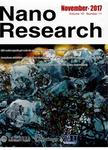Triboelectrification based on double-layered polyaniline nanofibers for self-powered cathodic protection driven by wind
Triboelectrification based on double-layered polyaniline nanofibers for self-powered cathodic protection driven by wind作者机构:State Key Laboratory of Solid Lubrication Lanzhou Institute of Chemical Physics Chinese Academy of Sciences Lanzhou 730000 China University of Chinese Academy of Sciences Beijing 100049 China
出 版 物:《Nano Research》 (纳米研究(英文版))
年 卷 期:2018年第11卷第4期
页 面:1873-1882页
核心收录:
学科分类:07[理学] 082304[工学-载运工具运用工程] 070205[理学-凝聚态物理] 08[工学] 080501[工学-材料物理与化学] 0805[工学-材料科学与工程(可授工学、理学学位)] 0823[工学-交通运输工程] 0702[理学-物理学]
基 金:Thanks for the financial support of the National Natural Science Foundation of China (Nos. 21573259 and 21603242) the outstanding youth fund of Gansu Province (No. 1606RJDA31) and the "Hundred Talents Program" of Chinese Academy of Sciences (D. A. W.)
主 题:polyaniline triboelectric nanogenerator wind-driven self-powered cathodic protection
摘 要:Polyaniline nanofibers (PANI NFs) are introduced to construct a wind-driven triboelectric nanogenerator (TENG) as a new power source for self-powered cathodic protection. PANI NFs serve as a friction layer to generate charges by harvesting wind energy as well as a conducting layer to transfer charges in TENG. A PANI NFs-based TENG exhibits a high output performance with a maximum output voltage of 375 V, short current circuit of 248 μA, and corresponding power of 14.5 mW under a wind speed of 15 m/s. Additionally, a self-powered anticorrosion system is constructed by using a PANI-based TENG as the power source. The immersion experiment and electrochemical measurements demonstrate that carbon steel coupled with the wind-driven TENG is effectively protected with an evident open circuit potential drop and negative shift in the corrosion potential. The smart self-powered device is promising in terms of applications to protect metals from corrosion by utilizing wind energy in ambient conditions.



